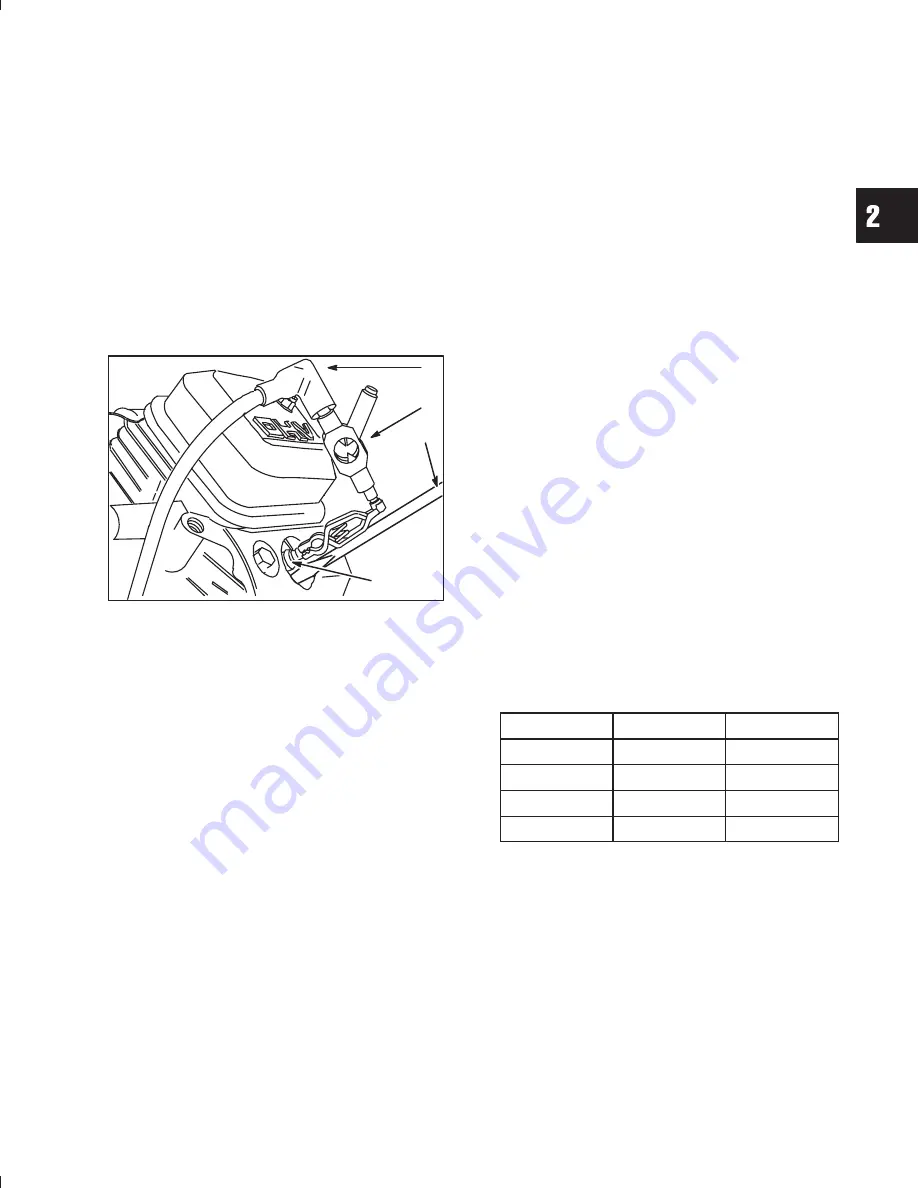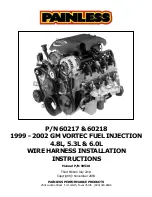
2
LOCKED FOR PRINTING – SELECT SECT. NEEDED >
29
Fouled Plug or Dead Cylinder
To test for a fouled spark plug or a non-functioning
cylinder, attach Ignition Tester
#19368
(2) between
the spark plug lead (1) and each spark plug (4). With
engine running at top no-load speed, use a
screwdriver (3) with an insulated handle to ground
one spark plug by contacting the alligator clip on the
ignition tester to a good ground on the engine,
Fig.
3
. The engine should continue to run on the other
cylinder. Repeat this test with the other cylinder. If
the engine dies when performing this test, the
cylinder that is NOT grounded is not functioning
and/or the spark plug is fouled. Install a new spark
plug and re-check. If miss continues see the
following procedures.
Fig. 3
Carburetion
NOTE:
Gaseous fuel engines use carburetors that
must be serviced by a certified gaseous fuel
installer or by a certified dealer for the equip-
ment powered.
Before performing a carburetion check, be sure the
fuel tank has an ample supply of fresh, clean gaso-
line. Be sure that the shutoff valve, if equipped, is
open and fuel flows freely through the fuel line be-
fore starting engine. Inspect and adjust the idle
needle valve. Make sure the choke closes com-
pletely. If engine will not start, remove and inspect
the spark plugs.
If plugs are wet, look for –
1. Overchoking
2. Excessively rich fuel mixture
3. Water in fuel
4. Float needle valve stuck open
5. Plugged air cleaner
If plugs are dry, look for –
1. Leaking carburetor mounting gaskets
2. Gummy or dirty carburetor, fuel line or tank
3. Float needle valve stuck shut
4. Inoperative fuel pump
5. Inoperative anti-afterfire solenoid
To determine if fuel is getting to the combustion
chamber through the carburetor, remove either
spark plug and pour a small quantity of gasoline
through the spark plug hole. Replace the spark plug.
If the engine fires a few times and then stops, look for
the same conditions as for a dry plug.
Compression
Compression Test
Briggs & Stratton does not publish compression
pressures, as it is difficult to obtain an accurate
reading without special equipment. An assessment
of the engine’s compression can be made as follows:
Remove both spark plugs and insert a compression
gauge into either cylinder (one cylinder at a time).
Turn engine over with engine starter until there is no
further increase in gauge pressure reading. Record
this reading. Repeat procedure on other cylinder and
record that reading. Divide the difference between the
cylinders by the compression pressure of the higher
of the two cylinders. A difference over
25%
between
the cylinders indicates a loss of compression in the
cylinder with lower pressure. See example below.
Engine #1
Engine #2
Cylinder #1
65 PSI
75 PSI
Cylinder #2
60 PSI
55 PSI
Difference
5 PSI
20 PSI
% Difference
7.7%
26.7%
If compression is poor, look for –
1. Loose cylinder head bolts
2. Blown head gasket
3. Burned valves, burned and/or loose valve seats
4. Insufficient valve clearance
5. Warped cylinder head
6. Warped valve stems
7. Worn bore and/or rings
8. Broken connecting rods
Содержание OHV V-Twin
Страница 27: ...1 26...
Страница 113: ...4 112...
Страница 156: ...10 155 Section 10 Crankshafts and Camshafts Page INSPECT CAMSHAFT 156 INSPECT CRANKSHAFT 156 INSPECT FLYWHEEL 157...
Страница 159: ...10 158...
Страница 177: ...12 176...
















































